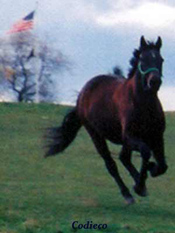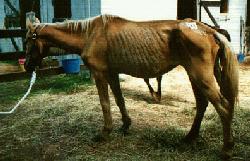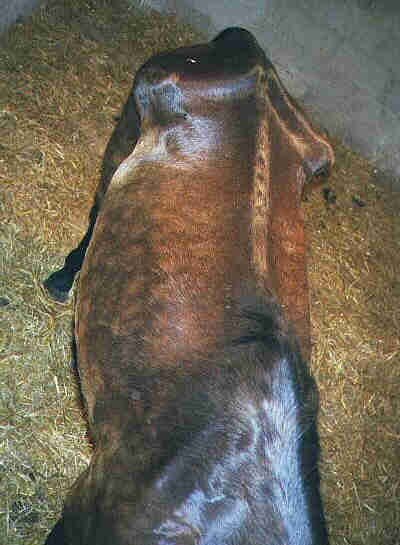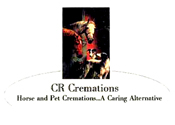
Join the EPN Announcement Only Mailing List
Support the EPN
Shop for CD's at CDRush.com & the EPN Benefits!
Put "EPN" in the Coupon Code box when you place your order.
Now you can save money on your favorite music and help the horses at the same time!
General
Press
Horse Slaughter
Horse Transport
Horse Cruelty
Legislation
Horse Statutes
Stolen Horses
SiteIndex
Horse Rescue
- EPN Sanctuary Program
- PA Horse Rescues
- Horse Rescues
- Horse Auctions
- Adopting Horses
- Donating Horses
- Mounted Police Units
- Starting A Rescue
- Horse Euthanasia
- Slaughter is Not For Pet Food!
- Rendering Companies
- PA Dead Animal Act- Is it Legal to Bury Your Horse?
Rescue Stories
Turning Copper Into Gold
July 1996
Mare is Saved From Auction-Scored a Minus 1 On the Henneke Chart!

The Miracle Mile
July 1990
Pregnant Mare Foals Hours After Rescue From Slaughterhouse-
Foal is a Stakes Winner!

The Horse That The Killers Refused to Bid $5.00 On
July 1999
Emaciated and Sick Gelding Is Saved From Auction!
No charges ever filed...

Links
California Voters "Just Say Neigh" to Horse Slaughter!
HoofPAC
Shop online at IGive.com with over 600 great stores you know & love- including Back In the Saddle! Up to 26% of the purchase price is donated to the EPN!
Join today!The EPN gets $5 extra the first time you shop!
PayPal accepts credit cards! Please send your tax deductible donation to the:Equine Protection Network, Inc.,
P. O. Box 232, Friedensburg, PA, 17933.
HoofPAC is the political action committee that has been formed to end the slaughter of America's horses. Cathleen Doyle, founder of HoofPAC, led the successful Save The Horses campaign in 1998 that made the slaughter of California's horses a felony.

Support the EPN by Shopping at IGive.com and by Searching the Net Using GoodSearch.com!
Horse Euthanasia Procedures
Pet Loss Support
Definition of the term euthanasia
The term euthanasia is derived from the Greek terms eu meaning "good" and thanatos meaning "death." Euthanasia means the good death. The average person defines euthanasia in lay terms as, "putting a horse to sleep" or "putting a horse down". The adjective "humane" is often used in conjunction with the term euthanasia. The understanding is that euthanasia is pain free and peaceful. The act of going to sleep is a pleasant and pain free experience.
Euthanasia is defined differently for animals that are considered pets than for those who are considered food animals. The horse is the only animal that is not raised for food and fiber and is thought of as a companion animal, but which is also slaughtered for human consumption. The agricultural and animal research community defines euthanasia or humane euthanasia to include methods of killing animals that the average person would consider painful and terrifying. The mass killing of animals by use of the captive bolt, guns, electrocution, gas and other methods does not meet the criteria of a "good death".
A research scientist will refer to a barbiturate overdose for a horse as euthanasia to horse owners. But the same research scientist will change the definition of euthanasia to include stunning the horse with a captive bolt followed by a cutting of the horse's throat when consulted by the agricultural community.
Thus the definition of the term euthanasia by the agricultural and research community to include methods used to slaughter animals is not a true definition, rather a definition developed to mislead the lay person into believing that the slaughter of animals is pain free and peaceful so as to justify their methods.
An example is the Humane Slaughter Act. The majority of people viewing the mass killing of animals or people would not consider the process humane.
Euthanasia must be swift and free from pain and panic.
Process of Euthanizing a Horse
Making the Decision
The decision to euthanise a horse is not an easy one. Emergency situations requiring euthanasia include certain critical injuries and illness that leave the owner no choice but to end the horse's suffering. Non-emergency situations include terminal and or chronic illness or conditions, or the financial cost of treatment for an injury or illness. Economic, emotional, and space limitations can force an owner to consider euthanasia for a horse if a suitable home is not available. Other reasons to consider euthanasia are a horse that has become dangerous and unmanageable.
The horse's veterinarian is best qualified to examine and evaluate the horse's condition, and to discuss potential disabilities and long-term problems with the owner.
Location
Horses can be euthanised on the farm, on the racetrack, at the boarding stable where they are kept or at the scene of an accident. There is no need to transport a horse to a special facility to perform euthanasia.
When possible the specific location must be accessible by removal equipment. Removal equipment may be a truck that is especially designed to transport dead animals or a backhoe. Due to the condition of the horse, it may not be possible to move the horse without causing further pain and suffering. A quiet, open grassy area is an ideal location for euthanizing a horse.
Depending on laws, regulations and availability, a horse's body may be buried, cremated, rendered or taken to a landfill.
Who Performs Euthanasia
Licensed veterinarians are required to perform euthanasia because the drugs used are a controlled substance by the Food and Drug Administration, FDA. Horses that are euthanised with drugs cannot be used for human consumption due to the drug residue in the meat.
Method
Two people are needed to perform the euthanasia procedure. A handler is needed to hold the horse while the veterinarian administers the drugs.
The veterinarian may prefer to pre sedate the horse with a tranquilizer. This allows the handler to better control the fall and reduces the horse's unconscious and reflex movements. A violent fall and reflex movements can be very disturbing to the horse's owner and observers who are not familiar with a horse being euthanised. The drug overdose is delivered via an intravenous injection in the horse's neck. The veterinarian will use two 60cc syringes to administer 120ccs of the barbiturate to the average 1000 pound horse. The drugs used, (barbiturates, anesthetics), directly depress the central nervous system. The overdose leads to a depression of breathing and cardiac arrest.
The horse may or may not become ataxic (wobbly) upon delivery of the drug. The drugs will cause the horse to lose consciousness and collapse. Due to their large size most horses tend to drop rather suddenly. Some horses may go over backwards or lunge forward. It is helpful to realize that a horse that is being put under anesthesia for surgery also collapses to the ground in much the same manner. During surgery a horse's eyes will remain open, the same as a horse that has been euthanised. The horse's mouth will open and often their eyes will roll back in their head. This can be very disturbing to the owner and or the horse's caretakers. Again, it is helpful for the observers to understand that these same actions and movement occur when the horse is going under for surgery. The horse is unconscious and feels nothing. Frequently following euthanasia, muscle tremors and involuntary jerking take place. The horse's legs may move and there may be an exhalation or gasping sound. The owner and observers may be disturbed by this, but should understand that these are unconscious movements. The horse is actually unconscious and feels nothing just before the initial fall. People who have undergone general anesthesia realize just how quickly the drugs take effect. The horse's breathing stops and then the heart. Owners and observers must also remember that in a non-emergency euthanasia the horse is in a familiar surrounding. The horse is led outside by a familiar handler and receives an injection. The horse does not realize or know what the veterinarian has in the syringe. There is no panic. There is no pain. There is no trauma. To consider this method inhumane, would be to consider putting horses under general anesthesia inhumane.
Confirmation of Death
Confirmation of death is essential. The horse must be checked within 5 minutes to confirm death. Death may be confirmed by the absence of breathing, a heartbeat, and a corneal reflex (a blink). The veterinarian will check for a corneal reflex (blinking response), by touching the horse's cornea (surface of the eye); there should be no response to the touch if the horse is dead. The presence of any eye movement or blinking at this time is evidence of sustained or recovering brain activity. If that were to happen, the veterinarian would administer more drugs to the horse.
Drugs Used
Sodium Pentobarbital
The barbiturate, Sodium Pentobarbital is the most widely used drug, and is the drug of choice for euthanizing horses. Barbiturates depress the central nervous system, with unconsciousness progressing to depression of breathing and finally cardiac arrest. The advantage of barbiturates is speed of action. This effect depends on the dose, concentration, and rate of injection. Barbiturates induce euthanasia smoothly, with minimal discomfort to the animal.
T-61
The drug T-61 is considered inhumane by many veterinarians. The horse is paralyzed but fully conscious.
The horse is suffocating and is fully aware. This drug was often used to benefit the observers of a horse being euthanised, such as at the racetrack. Due to the horse's lack of movement the fans wrongly assumed that the horse was instantly dead. T-61 is a nonbarbiturate, non-narcotic mixture of three drugs. These drugs provide a combination of general anesthetic, curariform, and local anesthetic actions. T-61 has been withdrawn from the market and is no longer manufactured or commercially available in the United States. It is available in Canada. It contains a local anesthetic, a strong hypnotic agent that depresses the central nervous system causing unconsciousness and another drug which has a paralytic effect on the respiratory center and a relaxing effect on skeletal muscles.
Summary
When owners purchase their horses, they assume responsibility for their horses' health and welfare. Preparing in advance for euthanasia can make an emotional and difficult decision less traumatic for all involved.
American Veterinarian Medical Association, AVMA, on Equine Euthanasia
Commitment - Do You Know Where Your First Horse Is?Make the Commitment to Your Horse andSave America's Horses!
|
|||||||
Private Horse Cremation

CR Cremations guarantees that each cremation is private.
Charles and Kathryn Rohrer
Phone and Fax: 717-687-6940
Horse & Pet Cremations since 1994
690 Strasburg Road,
Paradise, PA 17562

